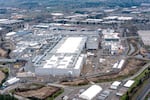
Intel celebrates the grand opening of Mod3, a more than $3 billion investment to expand Oregon’s D1X development factory, on April 11, 2022. The expansion of D1X in Hillsboro, Oregon, gives Intel engineers more clean room space to develop the next generation of silicon technologies.
Courtesy of Intel Corporation
Intel executives celebrated the opening of a $3 billion research expansion on the company’s main Oregon campus Monday, months after the company announced projects in Ohio, Arizona and Europe, which will collectively get more than $70 billion in new construction.
Related: Oregon loses out on new semiconductor manufacturing campus
At Monday’s ceremony, senior Intel officials said they have a legacy in Hillsboro and an ongoing commitment there.
“For the last 47 years, Intel has been investing and innovating in Oregon,” Ann B. Kelleher, Intel’s executive vice president and general manager of technology development, said in a pre-recorded message that opened the company’s celebration Monday. “Our presence in Oregon is our largest in the world.”
Intel CEO Pat Gelsinger, both of Oregon’s U.S. senators and Gov. Kate Brown were in Hillsboro Monday to mark the grand opening of a $3 billion expansion of the D1X factory where Intel develops its most advanced microprocessors.
Hillsboro is the center of Intel’s research and development operations. The company develops new chips and begins high-volume production at the D1X factory. That high-volume production continues at manufacturing sites around the world.
The D1X expansion, known as Mod3, began in 2019 and adds 270,000 square feet of clean-room space — a 20% increase, according to company officials.
Oregon-based lawmakers pledge support for federal legislation
Speakers at the event Monday said partnerships between Intel’s business executives and government leaders at the national, state and local levels are critical to the U.S. and Oregon maintaining a strong position in the global semiconductor industry. From Intel leaders, the emphasis mostly came in the form of thanks. From elected officials, it was conveyed through pledges of further support.
“We want America not to be a ‘follow the rest of the world’ in the production of chips or hold a small percent of the production chips,” said Sen. Jeff Merkley, D-Oregon, at the event Monday.
“We want the United States of America to be the world leader in producing the electronic chips here on planet Earth.”

Intel employees in clean room "bunny suits" work at Intel's D1X factory in Hillsboro, Oregon. The grand opening of D1X's "Mod3" in 2022 will provides Intel engineers with an additional 270,000 square feet of clean room space to develop next-generation silicon process technologies.
Courtesy of Intel Corporation
Merkley as well as Sen. Ron Wyden and Rep. Suzanne Bonamici all gave assurances that they would work to fund the CHIPS Act, a bill that would give $52 billion in federal investments and incentives to U.S. chip manufacturers.
Wyden told the audience at Intel that he and the other members of the Oregon delegation at the event will be heavily involved in upcoming steps for the semiconductor legislation: reconciling differences between bills passed by the U.S. House and Senate. Wyden warned that such conference committee debates “are not for the faint-hearted.”
“What we’re focused on is building a full toolkit for America to lead on semiconductors,” Wyden said. “So that means research, which very often involves grants and it also means changes in tax policy.”
Tax policy was also on Gelsinger’s mind, as he leaned on members of Oregon’s congressional delegation in attendance at the celebration to make changes to federal policy regarding research and development costs.
Gelsinger’s comment drew a shouted response from Wyden in the audience. He said the policy was “going to get fixed.” The Intel CEO thanked the senator, and acknowledged, “I’m rather upset about this one.”
Renaming Intel’s major campus
Company leaders repeatedly referred to the Hillsboro campus as the “crown jewel” of Intel’s operations, remarking on the nearly 22,000 employees in the state and their connections to local Washington County communities.
Gelsinger’s voice trembled with emotion, as he made another announcement Monday, that the company was changing the name of the 500-acre campus. It would become Gordon Moore Park at Ronler Acres, after Intel’s co-founder.
“Well Gordon? I hope we did you proud,” Gelsinger said, as if speaking to the 93 year-old co-founder, who was not in Hillsboro for the announcement.
“Thank you for being an innate, inextricable part of Intel.”
Gelsinger said the name change represents “longevity for decades to come” for Moore. The co-founder is already spoken of among Intel leaders on a regular basis, whenever they invoke “Moore’s law.” That’s the industry maxim that the size of a semiconductor is cut in half every two years — a trend that drives constant innovation for companies like Intel and its competitors.
